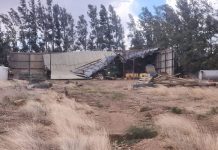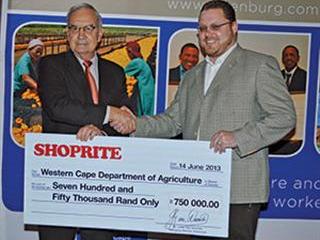Poultry producers in the KwaZulu-Natal Midlands have initiated a trial to partly replace expensive chicken feed with home-grown, live maggots, or grubs. Currently, Croft Farm poultry producer and processor Chris Slater uses the bucket system to grow maggots. He has 15 such systems, each consisting of two stacked buckets. A layer of chicken litter topped with chicken offal is placed in the top bucket and holes drilled in the lids of both buckets, as well as the bottom of the top bucket.
Flies enter the top bucket and lay eggs, which hatch 20 days later (depending on temperature). The maggots eat the offal, and when they’re at the optimum weight, they burrow through the chicken litter and fall through the holes into the bucket below – “clean, fat and juicy,” as Slater puts it.Slater produces 10kg of maggots every three days which are fed live to the chickens.
Costs nothing
“The maggots cost nothing to produce. We are re-using 10kg buckets that we get our marinade in; chicken litter from the houses; and chicken offal from the butchery. At the moment, 15kg of maggots save us purchasing 50kg of feed,” says Slater.
Highveld Farm free-range egg producer, Craig Alison has joined Slater. “With the cost of protein going the way it is, we have to look at alternative feed sources – and we as farmers have to work together,” he says.
In the Western Cape meanwhile, entrepreneurs David and Jason Drew are well down the path of commercialising maggot production at a pilot fly farm and larvae growth facility near Stellenbosch. Their business, AgriProtein Technologies, uses grubs to produce a dried, natural alternative to fish meal and poultry feed.
Recycle waste
According to Jason Drew, fish meal costs about R3 650/t, and AgriProtein’s product competes with that. “However, fish stocks are under immense pressure. It’s also increasingly clear that we need to recycle our waste. Our protein is sustainable because we’re recycling waste nutrients as would happen in nature,” he adds.
Nutrient recycling will become standard practice within a decade and ‘fly farming’ will become big business, he believes.
AgriProtein’s different fly programmes match the waste to the flies. For example, the domestic housefly or the blowfly utilises abattoir waste, while the black soldier fly prefers material such as manure and vegetable matter, which contain carbohydrates.
Positive response
Response from the livestock industries has been extremely positive. “There is almost no way we can keep up with demand. Pre-production testing has recently been completed and we are looking in the coming year to industrialise our process and then to franchise and licence our technology to allow many more people to recycle their waste,” says Jason Drew. Desired output from the industrial process is 100t/day wet larvae or 28t dried larvae or Magmeal, the brand name of AgriProtein’s maggot feed.
Grubs need to be harvested before they pupate when the protein content and digestibility is highest. A single female fly can lay 1 000 eggs a week, 1kg of which will turn into 380kg of protein within three days of hatching. Drew’s new book, The Story of The Fly and How it Could Save The World, co-authored with Justine Joseph, was recently launched. “It introduces the fly as a future hero that could help save the world by recycling waste nutrients and generating sustainable protein,” he explains.
“We must re-evaluate the fly and its role in nature.”










